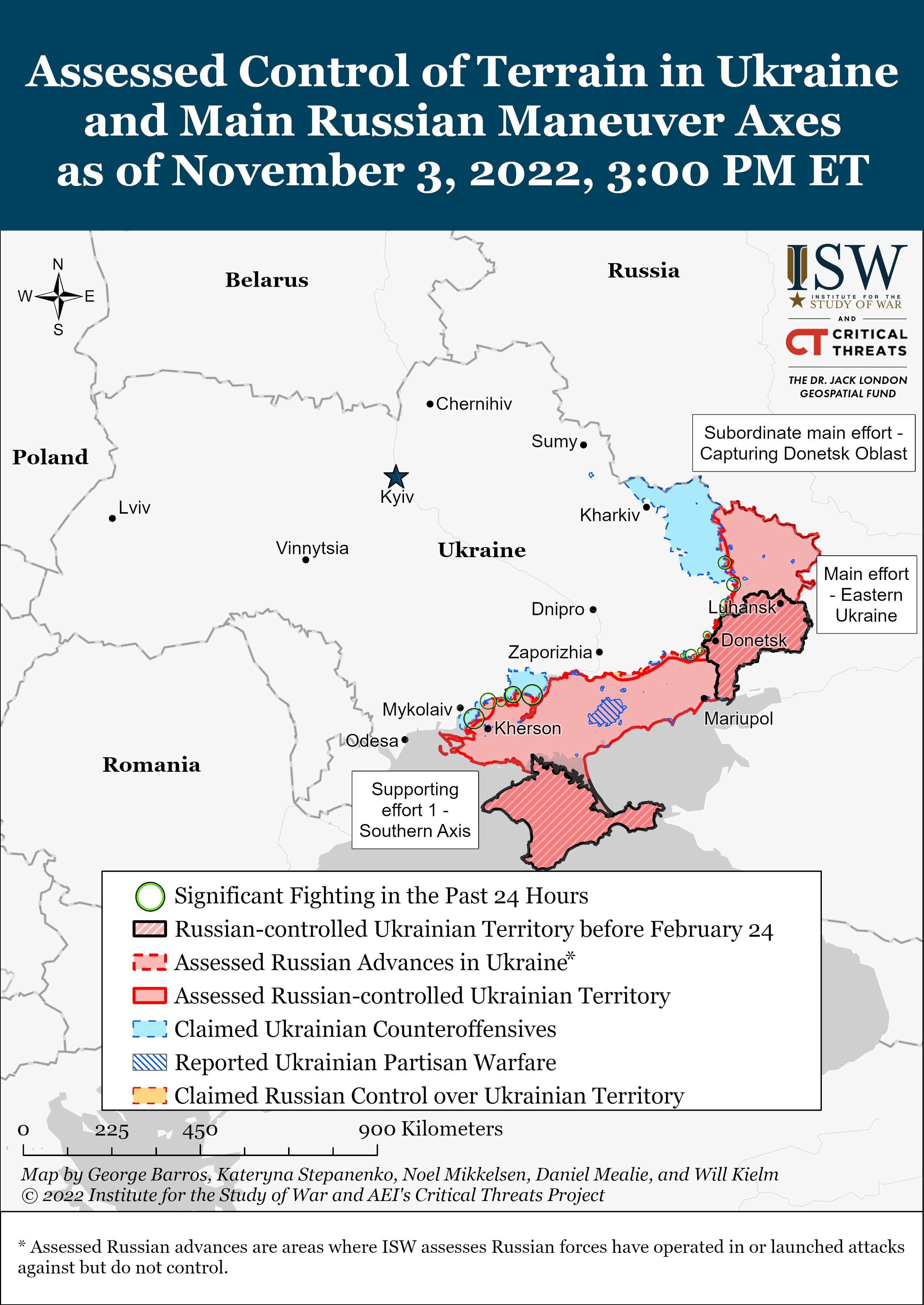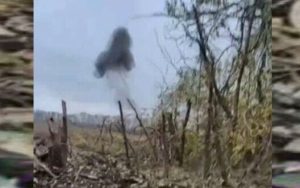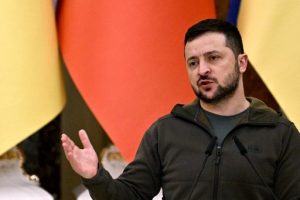
ISW Russian Offensive Campaign Assessment, November 3 – Kyiv Post
Key Takeaways
- It is still unclear whether Russian forces will defend Kherson City despite the ongoing withdrawal of some Russian elements from northwestern Kherson Oblast.
- Russian forces prematurely deployed newly mobilized personnel to offensive operations in western Donetsk Oblast in the pursuit of minimal and operationally insignificant territorial gains.
- Russian outlets continued to publish contradictory and confusing reports about the dismissal of Colonel General Alexander Lapin from the position of CMD commander or commander of the Russian “central” forces.
- Russian authorities may be setting conditions to imminently transfer the Zaporizhzhia Nuclear Power Plant to the Russian power grid.
- Russian sources claimed that Ukrainian forces continued to conduct counteroffensive operations in the direction of Kreminna and Svatove.
- Russian forces continued offensive operations around Bakhmut, Avdiivka, and Donetsk City.
- The Russian military continues to face pronounced issues in the supply of critical military equipment.
- The Russian Ministry of Defense is likely continuing mobilization efforts covertly.
- Russian occupation officials continued forced evacuations in Kherson Oblast.
Russian forces are continuing to withdraw some elements from northwestern Kherson Oblast, but it is still unclear if Russian forces will fight for Kherson City. Kherson City occupation deputy Kirill Stremousov stated on November 3 that Russian forces “will most likely leave for the left (eastern) bank” of the Dnipro River urging civilians to evacuate from Kherson City “as quickly as possible.” ISW has observed that Russian forces are continuing to prepare fallback positions on the left (eastern) bank of the Dnipro River while continuing to set up defensive positions northwest of Kherson City and transporting additional mobilized forces there, despite Stremousov’s statement. Some Russian elite units — such as airborne forces and naval infantry — are reportedly continuing to operate on the right (western) bank of the Dnipro River and their full withdrawal from northern Kherson Oblast would be a clearer indicator that Russian forces will not fight for Kherson City or settlements on the right bank. Stremousov also hypothesized about the probability of fighting in Kherson City and northern Kherson Oblast in the next two weeks, which may suggest that he anticipates some battles for Kherson City despite his comments about withdrawal. Stremousov is also an unreliable source who has consistently issued contradictory statements and made emotional responses to events, and his public statements may be clouded by personal fears of losing his position within the occupation government.
Ukrainian and Russian sources also extensively discussed the reported closure of some Russian checkpoints in the vicinity of Kherson City, the theft of city’s monuments, and the removal of a Russian flag from the Kherson Oblast Administration building as indicators of an ongoing Russian withdrawal from the city. A Russian outlet claimed that Russian officials removed the flag because the occupation administration moved to Henichesk by the Crimean border. While the relocation of the Kherson Oblast occupation government may suggest that Russian forces are preparing to abandon Kherson City, it may equally indicate that they are setting conditions for urban combat within the city. Similar reports may arise in coming days given the ongoing forced evacuation of civilians from both right and left banks of the Dnipro River but may not indicate an immediate withdrawal of Russian forces from Kherson City. The disposition of Russian airborne forces remains the best indicator of Russian intentions.
Russian forces prematurely impaled an insufficient concentration of mobilized personnel on offensive pushes near Bakhmut and Vuhledar, Donetsk Oblast, wasting the fresh supply of mobilized personnel on marginal gains towards operationally insignificant settlements. Ukrainian General Staff Deputy Chief Oleksiy Hromov stated on November 3 that one or two Russian motorized rifle companies with artillery and tank support conducted ground attacks within the past week to seize Pavlivka in an effort to reach Vuhledar, but that Russian forces have suffered losses due to Ukrainian defenses. Russian sources also acknowledged on November 3 that the rate of Russian advances near Vuhledar is slow due to Ukrainian resistance and mud. Hromov stated that Russian forces continue ground attacks at the expense of mobilized personnel, private military company forces, and former prisoners, and that the Russians conducted over 40 ground attacks in the Bakhmut, Avdiivka, and western Donetsk Oblast areas in the past 24 hours, sustaining over 300 casualties (100 killed) in just one direction. ISW has previously reported on the slow Russian rate of advance in Donetsk Oblast and injudicious allocation of resources on the front lines. Russian forces would likely have had more success in such offensive operations if they had waited until enough mobilized personnel had arrived to amass a force large enough to overcome Ukrainian defenses despite poor weather conditions. Russian attacks continuing current patterns are unlikely to generate enough momentum to regain the battlefield initiative. ISW offers no hypothesis to explain Russian forces’ impatience or their continued allocation of limited military assets to gaining operationally insignificant ground in Donetsk Oblast rather than defending against the Ukrainian counteroffensives in Luhansk and Kherson oblasts.
Russian outlets continued to publish confused reports regarding the dismissal and replacement of Colonel General Alexander Lapin from either his role as the commander of the Central Military District (CMD) or as the commander of the Russian “central” forces in Ukraine. The CMD press service told Kremlin-affiliated outlet Kommersant that the head of the organizational and mobilization department of the CMD, Major General Alexander Linkov, will temporarily replace Lapin as the CMD commander. The Russian Ministry of Defense (MoD) has not officially announced Lapin’s dismissal or replacement, and the CMD did not specify if Linkov will also take charge of the “central” forces in Ukraine. Unnamed Russian MoD sources had previously told other Kremlin-affiliated outlets that Commander of the 8th Combined Arms Army of the Southern Military District (SMD) Lieutenant-General Andrey Mordvichev would command “central” forces while Lapin is on a three-week medical leave.[12] Milbloggers with ties to the Russian state media also recently claimed that Mordvichev will also command the CMD. Such incoherent announcements by Russian MoD officials about the possible replacement of the second most-senior Russian commander in Ukraine is highly unusual for a professional military during a critical period of a war.
Russian authorities may be setting conditions to imminently transfer the Zaporizhzhia Nuclear Power Plant (ZNPP) to the Russian power grid following the International Atomic Energy Agency’s (IAEA) November 3 statements affirming that Ukrainian authorities are not misusing nuclear materials.The IAEA also stated on November 3 that shelling damaged external powerlines to the ZNPP in Ukrainian-held territory at points 50-60km away from the plant, completely cutting power to the ZNPP just one day after Ukrainian authorities transferred two reactors to a hot shutdown mode to generate heat for Enerhodar. This timing suggests that Russian authorities seek to force the transfer of the ZNPP to the Russian power grid by painting Russian control as the only viable option to provide electricity to the ZNPP and heat to Enerhodar and the surrounding area. The IAEA stated that backup generators are powering the ZNPP and have enough fuel for 15 days; Russian occupation authorities may transfer the ZNPP to the Russian power grid within this 15-day timeline. Russian Security Council Secretary Nikolai Patrushev claimed on November 3 that Russian authorities prevented a Ukrainian “terrorist attack” at the ZNPP, further suggesting that Russian authorities intend to paint themselves as the only safe operator of the ZNPP contrary to the IAEA’s findings of no indications of undeclared Ukrainian nuclear activities.


Average Rating